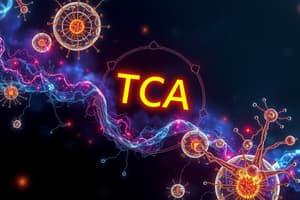Podcast
Questions and Answers
The citric acid cycle is also known as the tri-carboxylic acid (TCA) ______
The citric acid cycle is also known as the tri-carboxylic acid (TCA) ______
cycle
The citric acid cycle is also known as the ______ cycle, after its discoverer, Hans Krebs
The citric acid cycle is also known as the ______ cycle, after its discoverer, Hans Krebs
Krebs
The citric acid cycle primarily uses acetyl ______ as its starting material
The citric acid cycle primarily uses acetyl ______ as its starting material
{CoA}
The citric acid cycle harvests much of its bond energy in the form of ______ molecules
The citric acid cycle harvests much of its bond energy in the form of ______ molecules
The reduced electron carriers-NADH and FADH—generated in the TCA cycle will pass their electrons into the ______ transport chain
The reduced electron carriers-NADH and FADH—generated in the TCA cycle will pass their electrons into the ______ transport chain
The citric acid cycle takes place in the matrix of the ______
The citric acid cycle takes place in the matrix of the ______
The citric acid cycle is a closed loop; the last part of the pathway reforms the molecule used in the first step. The cycle includes eight major steps. In the first step of the cycle, acetyl ______ combines with a four-carbon acceptor molecule, oxaloacetate, to form a six-carbon molecule called citrate.
The citric acid cycle is a closed loop; the last part of the pathway reforms the molecule used in the first step. The cycle includes eight major steps. In the first step of the cycle, acetyl ______ combines with a four-carbon acceptor molecule, oxaloacetate, to form a six-carbon molecule called citrate.
After a quick rearrangement, this sixcarbon molecule releases two of its carbons as carbon dioxide molecules in a pair of similar reactions, producing a molecule of ______ each time.
After a quick rearrangement, this sixcarbon molecule releases two of its carbons as carbon dioxide molecules in a pair of similar reactions, producing a molecule of ______ each time.
The enzymes that catalyze these reactions are key regulators of the citric acid cycle, speeding it up or slowing it down based on the cell’s energy needs. The remaining four-carbon molecule undergoes a series of additional reactions, first making an ______ molecule—or, in some cells, a similar molecule called ______—then reducing the electron carrier ______ to ______, and finally generating another ______.
The enzymes that catalyze these reactions are key regulators of the citric acid cycle, speeding it up or slowing it down based on the cell’s energy needs. The remaining four-carbon molecule undergoes a series of additional reactions, first making an ______ molecule—or, in some cells, a similar molecule called ______—then reducing the electron carrier ______ to ______, and finally generating another ______.
Overall, one turn of the citric acid cycle releases two carbon dioxide molecules and produces three ______, one ______, and one ______ or ______.
Overall, one turn of the citric acid cycle releases two carbon dioxide molecules and produces three ______, one ______, and one ______ or ______.
The citric acid cycle goes around twice for each molecule of glucose that enters cellular respiration because there are two pyruvates—and thus, two acetyl [blank}]s—made per glucose.
The citric acid cycle goes around twice for each molecule of glucose that enters cellular respiration because there are two pyruvates—and thus, two acetyl [blank}]s—made per glucose.
In the first step of the citric acid cycle, acetyl [blank}] joins with a four-carbon molecule, oxaloacetate, releasing the ______ group and forming a six-carbon molecule called citrate.
In the first step of the citric acid cycle, acetyl [blank}] joins with a four-carbon molecule, oxaloacetate, releasing the ______ group and forming a six-carbon molecule called citrate.
In the second step, citrate is converted into its isomer, isocitrate. This is actually a twostep process, involving first the removal and then the addition of a water molecule, which is why the citric acid cycle is sometimes described as having nine steps—rather than the eight listed here.
In the second step, citrate is converted into its isomer, isocitrate. This is actually a twostep process, involving first the removal and then the addition of a water molecule, which is why the citric acid cycle is sometimes described as having nine steps—rather than the eight listed here.
In the third step, isocitrate is oxidized and releases a molecule of carbon dioxide, leaving behind a five-carbon molecule—α-ketoglutarate. During this step, ______ is reduced to form ______.
In the third step, isocitrate is oxidized and releases a molecule of carbon dioxide, leaving behind a five-carbon molecule—α-ketoglutarate. During this step, ______ is reduced to form ______.
The fourth step is similar to the third. In this case, it’s α-ketoglutarate that’s oxidized, reducing ______ to ______ and releasing a molecule of carbon dioxide in the process.
The fourth step is similar to the third. In this case, it’s α-ketoglutarate that’s oxidized, reducing ______ to ______ and releasing a molecule of carbon dioxide in the process.
Flashcards are hidden until you start studying




